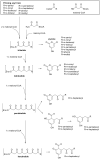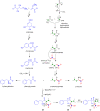From Genes to Molecules, Secondary Metabolism in Botrytis cinerea: New Insights into Anamorphic and Teleomorphic Stages
- PMID: 36771642
- PMCID: PMC9920419
- DOI: 10.3390/plants12030553
From Genes to Molecules, Secondary Metabolism in Botrytis cinerea: New Insights into Anamorphic and Teleomorphic Stages
Abstract
The ascomycete Botrytis cinerea Pers. Fr., classified within the family Sclerotiniaceae, is the agent that causes grey mould disease which infects at least 1400 plant species, including crops of economic importance such as grapes and strawberries. The life cycle of B. cinerea consists of two phases: asexual (anamorph, Botrytis cinerea Pers. Fr.) and sexual (teleomorph, Botryotinia fuckeliana (de Bary) Wetzel). During the XVI International Symposium dedicated to the Botrytis fungus, which was held in Bari in June 2013, the scientific community unanimously decided to assign the most widely used name of the asexual form, Botrytis, to this genus of fungi. However, in the literature, we continue to find articles referring to both morphic stages. In this review, we take stock of the genes and metabolites reported for both morphic forms of B. cinerea between January 2015 and October 2022.
Keywords: Botryotinia fuckeliana; Botrytis cinerea; diterpenes; metabolites; polyketides; secondary metabolism; sesquiterpenes.
Conflict of interest statement
The authors declare no conflict of interest.
Figures





















References
-
- Agrios G. Plant Pathology. 5th ed. Academic Press; Cambridge, MA, USA: 2004. 922p. - DOI
-
- Coley-Smith J.R., Verhoeff K., Jarvis W.R. The Biology of Botrytis. Academic Press; London, UK: 1980.
-
- Mansfield J.W. Mechanisms of Resistance to Botrytis. In: Coley-Smith J.R., Verhoeff K., Jarvis W.R., editors. The Biology of Botrytis. Academic Press; London, UK: 1980. pp. 181–218.
-
- Micheli P.A. Nova Plantarum Genera Juxta Tournefortii Methodum Disposita. Typis Bernardi Paperinii; Florence, Italy: 1729. - DOI
-
- Persoon C.H. Synopsis Methodica Fungarum. Henricus Dieterich; Göttingen, Germany: 1801.
Publication types
Grants and funding
LinkOut - more resources
Full Text Sources

